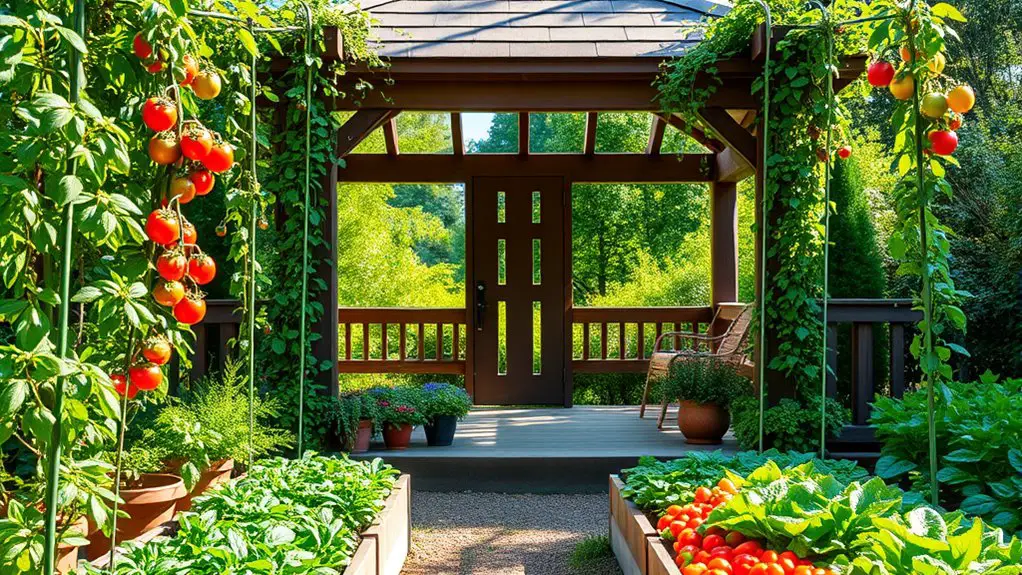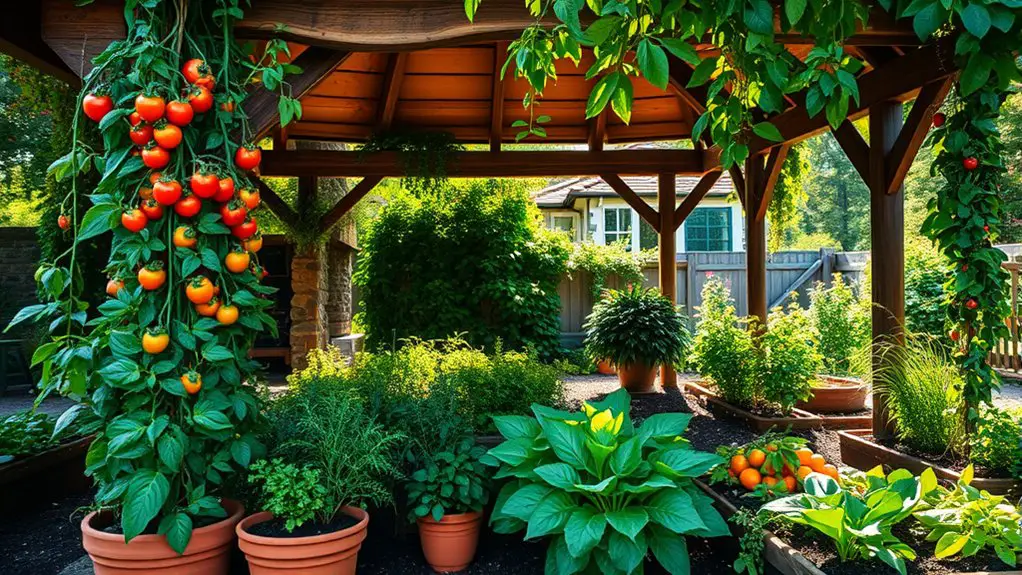To incorporate an edible garden around your gazebo, start by choosing a sunny spot with rich, loamy soil. Select fragrant herbs and vibrant edible flowers for color and aroma. Design winding pathways framed by seasonal blooms, creating an enchanting retreat. Use vertical gardening techniques to maximize space and add charm with climbing plants. Maintain your garden with care, ensuring it thrives. Each element invites exploration and relaxation; discover the ideal plants and techniques to enhance your beautiful oasis.
Choosing the Right Location for Your Edible Garden

When you’re dreaming of an edible garden enveloping your gazebo, the first step is to find the perfect spot. Picture a sun-drenched corner of your yard, where sunlight exposure dances across the ground, nurturing your plants. Look for a location that bathes in at least six hours of direct sunlight daily; this will help your veggies and herbs thrive.
Next, consider soil quality. You want rich, loamy soil that drains well while retaining moisture, a nurturing foundation for your botanical delights. Grab a handful of dirt and feel its texture; it should be crumbly yet moist. You can always amend it with compost, but starting with good soil makes all the difference.
With the right spot selected, you’ll set the stage for a vibrant garden that harmonizes with your gazebo, inviting you to savor the freedom of fresh, homegrown produce.
Selecting the Best Plants for Your Gazebo Garden
What plants will truly elevate your gazebo garden into a lush sanctuary? Imagine fragrant herb varieties like basil, mint, and rosemary, their scents wafting through the air as you relax in the shade. These herbs not only add flavor to your dishes but also attract beneficial insects, enhancing the ecosystem around your gazebo. Consider companion planting; pairing tomatoes with basil or cilantro with peppers can create a vibrant tapestry of colors and flavors, while maximizing space.
To further enhance your garden’s aesthetic, think about adding edible flowers like nasturtiums or pansies. Their vibrant hues will brighten your space and elevate your culinary creations. With thoughtful selections, your gazebo garden can transform into a delightful haven where nature meets nourishment. Embrace the freedom of growing your own food, and let every corner bloom with lush greenery that invites you to unwind and savor the beauty of your surroundings.
Designing a Cohesive Layout

As you envision your gazebo garden, consider how a well-planned layout can create a harmonious flow that invites relaxation and exploration. Begin by envisioning winding garden pathways that lead you through a tapestry of edible delights. These paths can guide you from vibrant herb beds to luscious berry patches, ensuring each step brings a new sensory experience.
Incorporate seasonal themes by planting flowers and vegetables that bloom and ripen throughout the year. Imagine sunflowers towering over a patch of tomatoes in summer, while autumn brings a cascade of colorful pumpkins and squash. To enhance the aesthetic, frame your pathways with fragrant lavender or creeping thyme, providing both beauty and a delightful aroma. Additionally, selecting flowers based on sun and shade requirements will ensure that your edible garden thrives throughout the seasons.
With careful planning, your gazebo garden will become an enchanting retreat, inviting you to wander, taste, and savor the fruits of your labor in a space that feels both cohesive and liberating.
Incorporating Vertical Gardening Techniques
To maximize your edible garden’s potential and create an enchanting visual display, incorporating vertical gardening techniques can be a game changer. Imagine your gazebo adorned with lush greenery, where vertical planters burst with life and color. These planters not only save space but also draw the eye upward, creating an inviting atmosphere.
Consider trellises or wall-mounted planters to support climbing vegetables like cucumbers, beans, and peas. As they reach for the sky, they’ll weave a tapestry of greenery that dances with the breeze. You can even mix herbs among them—think fragrant basil and rosemary—adding both beauty and flavor to your garden.
Don’t shy away from creativity; hanging pots can transform dull corners into vibrant, edible art. With these vertical techniques, you’ll embrace the freedom to grow more while crafting a picturesque retreat around your gazebo. Your garden can be both functional and a feast for the senses!
Maintaining Your Edible Garden for Optimal Growth

A thriving edible garden requires a delicate balance of care and attention, ensuring that each plant reaches its full potential. To maintain soil health, enrich it with organic compost, allowing nutrients to flow freely, nourishing roots as they dig deeper. Regularly check moisture levels; a gentle touch can tell you if your plants are thirsty or just right.
Pest management is equally essential. Embrace the natural allies—ladybugs and bees—while employing companion planting to ward off unwanted guests. A spritz of neem oil can help when things get tricky, but remember, nature often knows best. Incorporating climbing plants around your gazebo can also enhance your edible garden’s aesthetic while providing natural shade and privacy.
As you stroll through your garden, let the scents of fresh herbs and ripe fruits invigorate your spirit. By weaving care into each day, you’ll cultivate not just plants, but a sanctuary of freedom and flavor, bringing your gazebo’s edible landscape to life.
Frequently Asked Questions
Can I Use Containers for My Edible Garden Around the Gazebo?
Absolutely, you can use containers for your edible garden! With container gardening, you’ll enjoy the freedom to create a vibrant display of edible plants, enhancing your gazebo’s charm while savoring fresh flavors right at your fingertips.
How Do I Attract Pollinators to My Edible Garden?
To attract pollinators, you’ve gotta plant native plants and flowering herbs that buzz with life. Create a colorful haven, mixing textures and scents, and watch your edible garden thrive as nature’s friends flock to visit!
What Are Companion Plants for My Gazebo Garden?
When planning your gazebo garden, think about herb pairings like basil with tomatoes, or vegetable companions such as carrots with onions. These pairings not only enhance flavors but also create a vibrant, harmonious landscape for you to enjoy.
How Can I Keep Pests Away Naturally?
To keep pests away naturally, you can use natural repellents like garlic spray and plant herbs such as basil. Encourage beneficial insects like ladybugs, who’ll help maintain your garden’s balance, providing a harmonious, thriving space.
Is It Safe to Eat Herbs Grown Near a Gazebo?
Did you know that 75% of urban gardeners grow herbs? If your gazebo’s location is away from pollutants, you’re likely safe. Just guarantee you wash those herbs well, embracing nature’s bounty without worry. Enjoy your garden!

